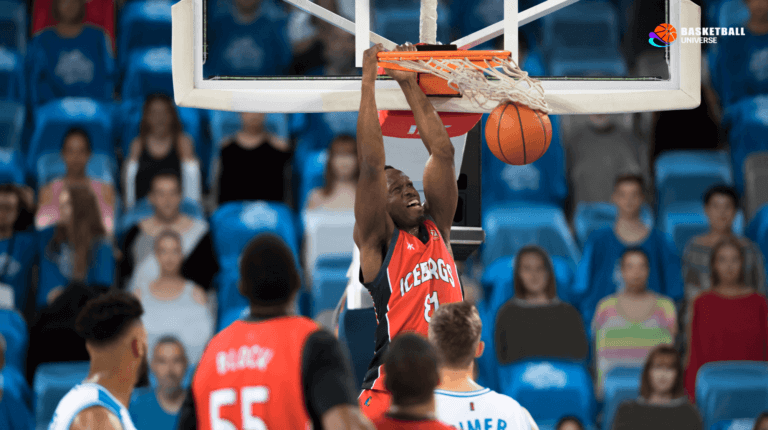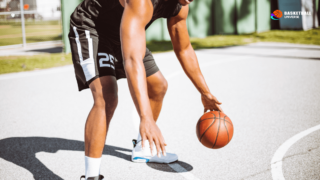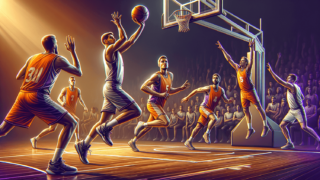
How to Treat Knee Pain from Basketball?
Written by: Basketball Universe
Last updated:

Welcome hoop fanatics and dedicated dribblers to our latest blog post, where we tackle the all-too-common issue of knee pain from playing our beloved sport, basketball! We know how frustrating it can be when persistent knee pain threatens to sideline your game, but worry not! We’re here to provide you with expert insight and practical tips on how to effectively treat and prevent those agonizing aches and get you back in the game, swishing it like the pros. So grab your court kicks, a tall glass of water, and let’s dive into the efficient strategies for addressing knee pain in basketball!
How to Treat Knee Pain from Basketball?
To treat knee pain from basketball, begin by resting and applying ice to reduce inflammation, followed by compression and elevation to alleviate swelling. Assess the severity of the pain and consult a medical professional if necessary. You can also incorporate targeted exercises to help strengthen the muscles surrounding the knee, and focus on proper stretching, warm-up, and cool-down routines. Opt for appropriate footwear and consider using braces or compression sleeves to provide additional support. Engaging in proper training, technique, and maintaining a healthy body weight also play a significant role in treating and preventing knee pain in basketball.
Let’s Breakaway from Knee Pain: The Ultimate Guide
Ready to take that game-winning step towards eliminating knee pain? Lace-up those sneakers and follow along as we delve deep into understanding the causes, treatments, and preventative measures associated with knee pain from basketball. It’s time to take charge and confidently step onto the court with knowledge and determination by your side!
Causes of Knee Pain in Basketball Players
Before we can effectively address the issues surrounding knee pain, it’s essential to understand the underlying causes. Basketball players often experience knee pain due to the high-impact nature of the sport, which places a considerable amount of strain on their joints. Let’s explore some of the most common culprits below:
Patellar Tendinitis: The Dreaded Jumper’s Knee
Patellar tendinitis, also known as jumper’s knee, is a common condition experienced by basketball players. This injury is caused by repeated stress on the patellar tendon, which connects the kneecap to the shin bone. With each gravity-defying jump or explosive change of direction, this tendon endures excessive strain, which may cause inflammation and pain.
Osgood-Schlatter Disease: When Age and Growth Team Up
Adolescent basketball players are particularly susceptible to Osgood-Schlatter disease; this condition occurs when rapid growth and repetitive stress cause the tibial tubercle (the bony prominence below the knee) to become inflamed, resulting in localized pain and swelling.
Anterior Cruciate Ligament (ACL) Injuries: A Basketball Player’s Nightmare
The ACL is a crucial ligament that provides stability to the knee joint. Unfortunately, it’s also vulnerable to injury, particularly during sudden pivots or forceful impacts. An ACL tear is a severe injury that often requires surgery and can keep players off the court for an extended period.
Meniscus Tears: When the Knee Cushion Gets Compromised
Meniscus tears are common knee injuries in basketball, especially among older players. The meniscus, composed of two pieces of cartilage that help cushion the knee joint, can tear or wear down as a result of repetitive use or trauma. A torn meniscus may cause pain, swelling, and limited range of motion.
The 5-Step Playbook for Addressing Knee Pain
Now that we’ve covered some of the primary causes of knee pain in basketball let’s dive into the five-step process to address and mitigate discomfort, keeping you on the court and at the top of your game!
1. Rest: Give Your Knees A Timeout
When dealing with knee pain, the first step is to take a break from the strain that caused it. Giving your knees time to rest and recover is essential. Temporarily reduce your participation in high-impact activities or even cease altogether, depending on the severity of your pain. As much as you want to stay in the game, remember that recovery is crucial for long-term success!
2. Ice: Putting Out the Inflammatory Fire
Applying ice to your knee is an excellent way to reduce inflammation and soothe pain. Using a cold gel pack or a bag of frozen peas, apply ice to the affected area for 15-20 minutes several times throughout the day. Be sure to use a towel or cloth between your skin and the ice to prevent frostbite. Stick to this method for the first 48 to 72 hours after noticing pain to help speed up recovery.
3. Compress and Elevate: Swelling’s Worst Enemies
Reducing swelling is vital in treating knee pain, and two effective methods are compression and elevation. Use a compression bandage or knee sleeve to apply gentle pressure on the knee, helping control inflammation. Furthermore, elevate your knee above heart level (for example, using a stack of pillows) when possible, as this encourages fluid drainage and further reduces swelling.
4. Consult a Medical Profession: Get Expert Attention
While mild knee pain can often be treated at home, it’s imperative to consult a medical professional if your pain is severe, persistent, or accompanied by considerable swelling and restricted movement. Physical therapists, sports medicine specialists, or orthopedic doctors can provide an accurate diagnosis and guide you towards the most effective treatment plan.
5. Strengthen and Stretch: Prepping for a Pain-Free Comeback
Building strength and flexibility in the muscles that support the knee is a crucial component of treating and preventing knee pain. Perform targeted strengthening exercises for the quadriceps, hamstrings, and calf muscles, as well as proper warm-up and cool-down routines that include dynamic and static stretching. This helps make your knees more durable and resistant to injury!
Extra Pointers for Prevention and Long-Lasting Performance
We’re always looking for additional ways to keep our basketball-loving readers in the game. Here are more tips to help prevent and address knee pain in basketball:
Choose the Right Footwear for Maximum Support
Wearing shoes specifically designed for basketball is essential in reducing the risk of knee pain. These shoes are optimized for the demands of the sport, providing proper support, cushioning, and traction. Replace your shoes regularly, as worn-out sneakers lose their effectiveness and compromise your joints’ protection.
Consider Using Braces or Compression Sleeves
You’ve likely spotted many professional athletes wearing braces or compression sleeves on their knees—that’s because these devices can provide additional support, improve blood circulation, aid in joint stabilization, and minimize swelling. Consider using them during practice sessions or games to alleviate pressure and strain on your knees.
Train Smart: Focus on Technique and Overall Fitness
A well-rounded training regimen that includes strength, flexibility, endurance, and agility can help prevent knee injuries and improve overall performance on the court. Additionally, paying attention to proper technique when jumping and landing, pivoting, and cutting can help minimize stress on the knees.
Maintain a Healthy Body Weight: Ease the Load on Your Knees
Excessive body weight can contribute to knee pain in basketball, as each additional pound places added stress on your knee joints. Maintaining a healthy body weight through a nutrient-dense diet and regular exercise can help lower your risk of knee injury and alleviate existing pain.
With this comprehensive guide, you’re now equipped with the knowledge and resources to help overcome knee pain from basketball. Get ready to bounce back from injury and unleash your full potential on the court!
Bonus Tips: Score Big in the Fight Against Knee Pain
With even more helpful tips and tricks up our sleeves, we’re here to ensure you have all the knowledge you need to tackle knee pain effectively. The battle-ready section below provides insights on alternative treatments, pain management, and critical mindset shifts to help you fully overcome knee pain in basketball.
Alternative Treatments: Opening the Door to New Possibilities
While traditional treatment methods play a vital role in addressing knee pain, a world of alternative therapies awaits, offering numerous benefits to basketball players on their quest for pain-free performance.
Massage Therapy: Soothe the Tension Away
Massage therapy can help relieve muscle tension, promote blood flow, and reduce pain in the knees. A certified massage therapist can use specialized techniques to address specific sources of pain, making it a valuable addition to your overall pain management plan.
Acupuncture: Aiming for Pain Relief
Acupuncture, a traditional Chinese medicine practice, has gained recognition as a viable treatment for various types of musculoskeletal pain, including knee pain. By strategically placing thin needles on specific points of the body, acupuncture aims to reduce pain and inflammation, offering potential relief for discomfort stemming from basketball-related injuries.
Hydrotherapy: Heal with the Power of Water
Hydrotherapy involves using water for pain relief and rehabilitation. Basketball players with knee pain can benefit from hydrotherapy sessions conducted in pools, whirlpools, or specialized therapy baths, where gentle water exercises and warm water immersion can help soothe joints, reduce inflammation, and alleviate muscle strain.
Pain Management Strategies: Relief When You Need It Most
While prevention and treatment remain the main focuses, it’s also essential to have pain management strategies in place if discomfort persists. From over-the-counter medications to relaxation techniques, there’s a range of options to help you cope with knee pain related to basketball.
Medications: Target Discomfort with Precision
Over-the-counter pain relievers such as ibuprofen, naproxen, and acetaminophen can help relieve knee pain caused by inflammation or injury. Remember, always consult a healthcare professional before starting any new medication regimen, and follow the recommended dosages and instructions.
Relaxation Techniques: Unlock the Power of Calm
Practices such as deep breathing, meditation, and progressive muscle relaxation can effectively combat knee pain when combined with other treatment methods. These relaxation techniques can help take the edge off discomfort, reduce stress, and boost your overall well-being during the healing process.
Adopting a Winning Mindset: Pain Won’t Stand a Chance
Last, but definitely not least, the journey to overcoming knee pain from basketball involves cultivating a determined, positive attitude. Treatment success and long-term prevention go hand in hand with adopting a proactive and resilient mindset.
Embrace Patience: The Road to Recovery Takes Time
Recovering from knee pain can be an arduous and, at times, frustrating process. It’s crucial to practice patience and remind yourself that true healing takes time. Trust the journey, stick to your treatment plan, and stay focused on making steady progress—one day at a time.
Stay Persistent: Keep Showing Up for Yourself
Recovery may be challenging, but it’s essential to stay committed to your pain management plan and maintain a consistent approach. By staying persistent, you build resilience and increase the odds of overcoming knee pain and returning to peak basketball performance.
With this new arsenal of tips and strategies at your disposal, you are now more than equipped to tackle knee pain from basketball head-on. Practice persistent, proactive, and patient action, and be prepared to experience a triumphant return to the court!
FAQ: Slam Dunking Your Knee Pain Doubts
If you’ve got a few lingering questions about knee pain in basketball, don’t worry! We’ve put together this comprehensive FAQ section to ensure you have all the answers you need to confidently address and overcome knee-related issues in the sport.
1. How can I tell if my knee pain is serious or not?
If you’re experiencing only mild discomfort that subsides after rest and following the recommended treatment steps, your knee pain is likely not severe. However, if your pain is persistent, causes swelling, restricts movement, or is associated with a traumatic injury, it’s essential to consult a medical professional for an accurate diagnosis and treatment plan.
2. What are some common mistakes players make when treating knee pain?
Common mistakes include neglecting to rest, ignoring professional medical advice, failing to consistently follow a targeted strengthening and stretching routine, and not addressing technique, footwear, or other contributing factors to knee pain.
3. How long should I rest from playing basketball if I have knee pain?
The duration of rest depends on the severity of your knee pain and the underlying cause, but it can range from a few days to several weeks. Always consult a healthcare professional for personalized advice on how long you should rest before returning to the court.
4. Can I use heat to treat my knee pain?
Heat therapy can be helpful for relieving muscle tension and stiffness, but it’s not typically recommended for treating acute inflammation. Stick to icing your knee during the initial 48-72 hours of noticing pain or inflammation and consider heat therapy afterward if it helps alleviate any residual discomfort.
5. How often should I replace my basketball shoes?
While there’s no specific timeline for shoe replacement, it’s recommended to replace them when signs of wear begin to affect performance, such as loss of grip, worn cushioning, or uneven outsoles. A general guideline is every 300-500 miles of use, but consider your play frequency and intensity as well.
6. Can I play through the pain?
Playing through knee pain can potentially worsen your injury and prolong the healing process. It’s essential to prioritize rest and recovery, following a comprehensive treatment plan, to prevent further damage and long-term complications.
7. Is knee pain from basketball a lifelong issue?
Knee pain may resolve entirely with appropriate treatment and preventative measures, but individual success depends on factors like the underlying cause, severity, and commitment to a consistent rehabilitation and strengthening routine.
8. Are there any supplements that may help with knee pain?
Some supplements, such as glucosamine and chondroitin sulfate, may help with joint health and knee pain. However, it’s always recommended to consult with a healthcare professional before starting any supplement regimen and remember that supplements should not replace a well-rounded treatment plan.
9. How can I prevent knee pain in the future?
Preventing knee pain involves adopting a consistent strength and flexibility routine, ensuring proper footwear, working on technique, maintaining a healthy body weight, and taking measures to manage inflammation and pain when they arise.
10. When should I consult a physical therapist for my knee pain?
If your knee pain is severe, persistent, or not improving with self-care measures, consider consulting a physical therapist. They can provide a personalized therapy plan to help reduce pain, improve joint function, and prevent further injury.
11. How can I improve my jumping and landing techniques to reduce knee strain?
Focus on proper body alignment, engage your core muscles, and be sure to land softly with slightly bent knees. Also, consider working with a coach or trainer to develop better jumping and landing mechanics that support proper knee function.
12. I’m an older basketball player. Are there any specific considerations for knee pain?
As you age, your risk for certain knee injuries like meniscus tears may increase. Additionally, age-related wear and tear or underlying conditions like osteoarthritis may contribute to knee pain. Consult with a healthcare professional who specializes in sports medicine for older athletes to address any age-specific concerns.
13. If I’ve previously experienced knee pain, is it possible to return to high performance in basketball?
Yes, many athletes successfully return to peak performance levels following a comprehensive treatment and rehabilitation plan for knee pain. Commitment to strengthening, flexibility, and overall joint health, as well as appropriate preventative measures
Featured Posts
- No pillar pages found.





